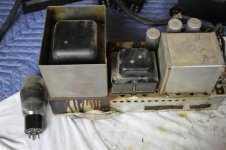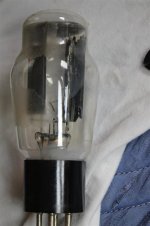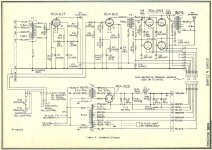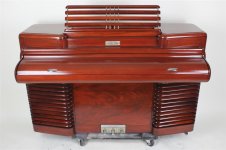The amp in question comes from a late-30's RCA-designed, Story and Clark electric piano, the Storytone. It is a 15W output beast, single channel, with four 2A3 tubes in push/pull parallel. It has two power transformers, and three signal transformers. At idle it consumes about 200W! The piano itself is beautiful, very 30's art deco, and was possibly the first electric piano.
I was able to find a schematic luckily. The power supply was fried at some point - I attached a picture of the melted transformer next to a 2A3 tube for size comparison. Its a pretty big transformer, and was used to generate the plate voltages. I'm hoping to be able to replace it, figure out what went wrong, and get the instrument working again.
Heres the evidence so far:
1) a 30 amp fuse, where a 3 amp is called for - duh!!
2) plate power transformer melted and still gooey
3) 5Z3 rectifier tube internally melted
4) no other components melted. One of the 2A3 tubes has very low output (tested at 40% quality on a hickok tester), but doesn't look to me like the reason the amp fried
The schematic shows that the plate transformer, T4, is supposed to have 120V in and 340Vac out. Its also says the primary is 2.9ohms and the secondary is 70ohm total. I actually have a second power supply with a good transformer, so I can do measurements on it if need be.
So my questions are, could the 5Z3 tube short internally, melting the transformer? And where/how can I replace the transformer? I'll have one custom made if need be.
I was able to find a schematic luckily. The power supply was fried at some point - I attached a picture of the melted transformer next to a 2A3 tube for size comparison. Its a pretty big transformer, and was used to generate the plate voltages. I'm hoping to be able to replace it, figure out what went wrong, and get the instrument working again.
Heres the evidence so far:
1) a 30 amp fuse, where a 3 amp is called for - duh!!
2) plate power transformer melted and still gooey
3) 5Z3 rectifier tube internally melted
4) no other components melted. One of the 2A3 tubes has very low output (tested at 40% quality on a hickok tester), but doesn't look to me like the reason the amp fried
The schematic shows that the plate transformer, T4, is supposed to have 120V in and 340Vac out. Its also says the primary is 2.9ohms and the secondary is 70ohm total. I actually have a second power supply with a good transformer, so I can do measurements on it if need be.
So my questions are, could the 5Z3 tube short internally, melting the transformer? And where/how can I replace the transformer? I'll have one custom made if need be.
Attachments
I have no answer to your question, just want to comment on what a beautiful object that piano is🙂
Are you sure the plate PT is bad? Have you checked it electrically?
I'd be certainly interested in also seeing a schem of the remainder of the piano - eg. the tone generation/sgnal processing.
Can you provide a photo of the underside circuitry?
Top stuff!
Ciao, Tim
I'd be certainly interested in also seeing a schem of the remainder of the piano - eg. the tone generation/sgnal processing.
Can you provide a photo of the underside circuitry?
Top stuff!
Ciao, Tim
Technically possible, but unlikely. More likely is a short somewhere else after the 5Z3. But for sure that 30 amp fuse caused the meltdown when it didn't blow. I've seen this too many times in various equipment where some moron puts a "slug" in place of a fuse.So my questions are, could the 5Z3 tube short internally, melting the transformer?
As far as transformer replacement goes, you'll have to search the various transformer manufactures listings for one that's close. I'd start with Edcor, Hammond, etc. And also search eBay for a good used or NOS Stancor, Thordarson, Triad and others. Having one made special would be my last resort because of cost.
Edcor can probably build something suitable for not obscene money, however it probably will not be physically identical.. There are transformer rewinders that could do a complete rewind on this transformer for what is probably a substantial cost - given the nature of the beast it might just be worth it.
Most likely one or more of the supply filter caps croaked. I have an Atwater Kent Radio from 1932, mostly original parts except for the electrolytics which I stuffed with modern caps. The originals were wet types and had totally dried out. (and shorted)
Most likely one or more of the supply filter caps croaked. I have an Atwater Kent Radio from 1932, mostly original parts except for the electrolytics which I stuffed with modern caps. The originals were wet types and had totally dried out. (and shorted)
The wax or pitch of old transformers would often melt out over time. For sure, excess expulsion indicates gross heating, but may not end in winding failure. A resistance test, followed by a low AC voltage excitation test, followed by a megger/insulation resistance test would be the first actions I suggest.
As a compromise, if you can find a similar transformer of the same core size, the end bells can be swapped to keep it looking original. I would be amazed if the winding WASN'T shorted or open, and wouldn't trust it if it did measure OK... as mentioned above, shorted cap would cause rectifier and transformer to fail.
Check the electrolytic cap's. I have some problem with old sets including tube rectifiers, in which electrolytic become shorted or very leaky. As the cap drains more current that rectifier can supply, it becomes red plated, and then gas is liberated inside the bulb. Then, more current, and so. The final is the filament melted, and touching the plate were arcing or directly shorted to an anode. In an old Paco oscilloscope S50, (from 70's ?) it happened with a 6CA3, when the final was the cathode shorted to heater. And more recently, with a restored Eico 368 signal generator of my own. Then, I rewind the transformer for 220V (The original was 110V primary), and made a separate heater wind to the 6X4 to prevent cathode-heater insulation damage. This set works with 380V cathode voltage, when RCA specifies about 200V absolute maximum between cathode-heater voltage.
In any case electrolytics caps have to be replaced.
And I second Edcor as the source for transformer.
You live quite far from SF Bay Area, and I have more project than can afford, otherwise I would offer my help in restoration of this beauty.
And I second Edcor as the source for transformer.
You live quite far from SF Bay Area, and I have more project than can afford, otherwise I would offer my help in restoration of this beauty.
I have no answer to your question, just want to comment on what a beautiful object that piano is🙂
It is absolutely stunning; I adore Art Deco and this instrument is a fine example indeed.
7N7
im actually suprised they didn't stuff a couple of 20 ohms carbon comps in series with each hv lead. carbon comp would blow. and save the transformer.
tear that xformer open and let us have a look, i propose. 😀
cheers. happy holidays!
tear that xformer open and let us have a look, i propose. 😀
cheers. happy holidays!
I thought transformers lasted forever?
Only if they are not subjected to abuse. 🙁 Unfortunately, failed magnetics are far too prevalent.
I too share the sentiment that the unit should be made functional again. What a nice piece to have in a "great" room. 😉
The UX4 based 5Z3 is electrically equivalent to the Octal based 5U4G. NOS of either type is anything but commonplace (read expensive) and "recent" production Russian and Chinese 5U4G "equivalents" are GUANO. The most cost effective solution to the rectifier replacement problem is installation of an Octal socket to hold a current production EH 5U4GB. The New Sensor product is quite decent and it's affordable. 😀
Heyboer is a possible place to go to have the (presumably) failed power trafo reconstructed exactly.
BTW, consider selling the strong OS 2A3s off and buying a set of Sovtek tubes. The Saratov made product has good sonics and it's tougher than OS. So, service life should prove lengthy.
I have seen one of these pianos up close in a garage.Still had the original rca 2a3's in it.They wanted several thousand for it unrestored.Too much in my opinion.
The filter electrolytic caps likely shorted, and in turn that fried the rectifier and possibly damaged the power transformer. I'd replace the electrolytics and all wax paper caps too.
I thought transformers lasted forever?
What a beautiful piano!
Eli already addressed that, but a personal observation/anecdote - AC mains voltages can be as much as more than 15% higher in many locations today as those on which amps of 50-80yrs ago were designed to operate.
About 7-8 yrs ago I obtained a pair of badly beat up and poorly repaired Scott 222 / LK48 amps, and sacrilegiously stripped them down to bare chassis and rebuilt as basic power amp.
Who knows how long these may have sat dormant, but let's assume they had a good 30yrs of use. Even after being relieved of heating a string of something like 10 signal and output tubes plus the rectifier, the cumulative effect of those decades of thermal load, exacerbated by deterioration of numerous other parts, one of the mains transformers simply decided it was time to quit.
If you've never had the experience of one of those going Chernobyl, trust me, rather like sitting through "Prometheus", it's one you'll not soon forget.
The filter electrolytic caps likely shorted, and in turn that fried the rectifier and possibly damaged the power transformer. I'd replace the electrolytics and all wax paper caps too.
I couldn't agree more. Every electrolytic and waxed paper cap. must be replaced. Also, the old carbon composition resistors should be checked for drift. Unless physically damaged, leave wirewound resistors be.
I took another look at the schematic and saw something troublesome. Notice that the rectifier is feeding a paralleled pair of 30 μF. 'lytics. The 60 μF. sum exceeds the limits shown on the 5U4GB data sheet. While there are several ways to tackle the issue, simply installing a CL-90 inrush current limiting thermistor in the line between the rectifier and the PSU filter consumes very little space and involves no sheet metal work. 😉 Overall, that could be "best".
I have seen one of these pianos up close in a garage.Still had the original rca 2a3's in it.They wanted several thousand for it unrestored.Too much in my opinion.
You might think that
1939 RCA Storytone First Electric Piano | eBay
gorgeous piece of work, but holey freaking crapola - over course being grotesquely overpriced doesn't mean the seller won't get what they're asking
For a real rebuilding / retubing nightmare, check out the Hammond Novachord
Novachord Restoration Project
Last edited:
Merry Christmas. I wouldn't use Edcor. They took 8 weeks to build me a power trannie and when I finally received it buzzed like crazy. They insisted it was my fault, even though it even buzzed w/o a load connected to it. Then they gave me hard time when I tried to return it. Never again. I now go to Alden at Heyboer for all my transformers. I never had a problem with them.
- Status
- Not open for further replies.
- Home
- Amplifiers
- Tubes / Valves
- Post-mortem on a 80 year old 2A3 amp



